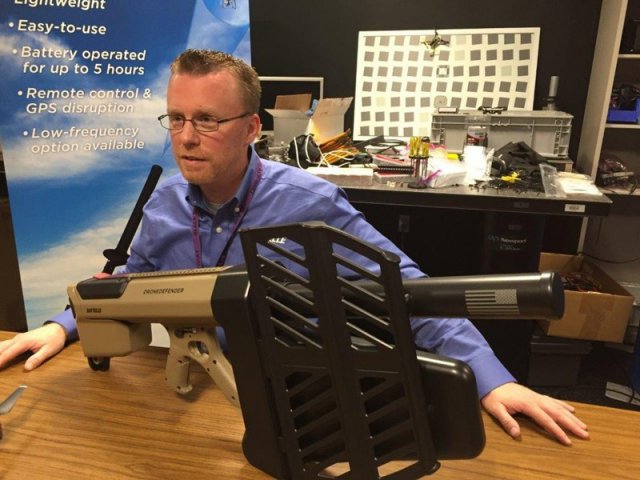Ohio prison authorities are considering the use of anti-drone technology to keep small remote-controlled aircraft from being used to deliver drugs and other contraband to inmates.
The plan follows several incidents in recent years where someone attempted to break through prison security using a drone.
The traditional method to smuggle contraband into prisons “approaching our perimeter and propelling the package of contraband over the fence into an area inside the prison where the recipient is expecting it to be so they can retrieve it,” said Ed Voorhies, Managing Director of Operations, Ohio Department of Rehabilitation and Correction.
With a drone, Voorhies said almost anyone can try to breach security and fly directly into the prison yard.
In a 2015 incident, two drones were used to make a delivery at the Mansfield Correctional Institution. One drone was spotted by security and flew off. Another one dropped a package into the prison’s recreation area.
The Ohio State Highway Patrol Investigation report, obtained through a public records request by the I-team, said the drone carried “144.5 grams of tobacco in 7 bags, 6.6 grams of heroin and 65.4 grams of marijuana.”
The report states the drop was intended for one gang, the Gangster Disciples, but it ended up going to a rival gang, the Heartless Felons. A fight broke out between the two gangs when an inmate attempted to hide the package in a building for retrieval later. Corrections officers stopped the fight, recovered the package and searched the area for additional contraband, coming up empty handed.
A highway patrol investigation determined that the package was delivered by a “Verizon AR Drone by Parrot” which costs about $300. The company’s web site features several models, all of them small quadcopters. When the prison perimeter was searched, authorities found no operator of the drone and no suspects were located.
The drone attack came as no surprise to Jamie Fant of Trotwood, who spent 18 years working in the prison system. He said inmates and their counterparts on the outside can be very creative when it comes to plotting ways to bring drugs and weapons into the prison.
It’s a scary thought,” Fant said. “They can find ways to breach security big time.”
According to Voorhies, the prison system is considering installing a new technology to detect drones near secure areas and to deter any illegal smuggling. Anti-drone mechanisms like the “DroneDefender” – invented by the Columbus-based research and development firm Battelle – disrupt the craft’s control signal and brings the aircraft to the ground.
Dan Stamm and Alex Morrow, co-inventors of the “DroneDefender,” said it is a mobile unit that is effective in bringing down a small drone.
“We specifically set out to sever that link between the pilot and the drone,” Stamm said. So far it has been sold exclusively to the U.S. Defense Department and the Department of Homeland Security. They have sold more than 250 units. Battelle declined to provide price information.
“Every time they pick it up and they shoot they can see the effects on the aircraft and they know it works,” Morrow said.
Even if the “DroneDefender” would be available on the open market, it will not be used by the prison system anytime soon. “I have different rules of engagement than the military,” said Voorhies, “I have a military background and I have to worry about what happens if I interrupt the signal on that drone and it spins out of control and goes through the living room window in the residence adjacent to the prison.”
Some corrections officers who work the perimeter of prisons have asked “Why can’t we just shoot them down?”
Voorhies has been quick to point out that it would be a bad move for several reasons. Chief among them, said Voorhies, is that under federal law a drones is considered to be an aircraft and even if it is suspected of being involved in an illegal act it would be against the law to shoot it down.
Rather than purchasing a mechanism to attack drones directly, the state is considering systems that detect them electronically.
“We are piloting some technology that gives us that capability and testing the efficacy as we speak, look at things like forward-looking infrared technology coupled with radar,” Voorhies said. “We are looking at technology that detects the signal from the controller and the drone, the remote-control signal.”
No decisions have been made to date on the purchase of an anti-drone system.
“The ones we have seen so far are pretty costly, so that’s why we continue to look,” Voorhies said.
Experts expect anti-drone technology to become much more commonplace in the future, not just at prisons, but also at outdoor stadiums and concert venues.
Ryan Palm, Unmanned Aerial Systems Program Coordinator at Sinclair Community College, said several systems have already been used for security at large events such as the Boston Marathon.
“They set up a geo-perimeter so that anything that flies into that area that is drone related gets turned around or gets told to land,” Palm said.
He predicts fixed systems will be deployed at stadiums and at many locations where large numbers of people gather, creating a bubble of security.
Photo: Battelle’s Dan Stamm with the drone defender he helped invent. Credit – BYRON STIRSMAN
Source: Daytona Daily News

